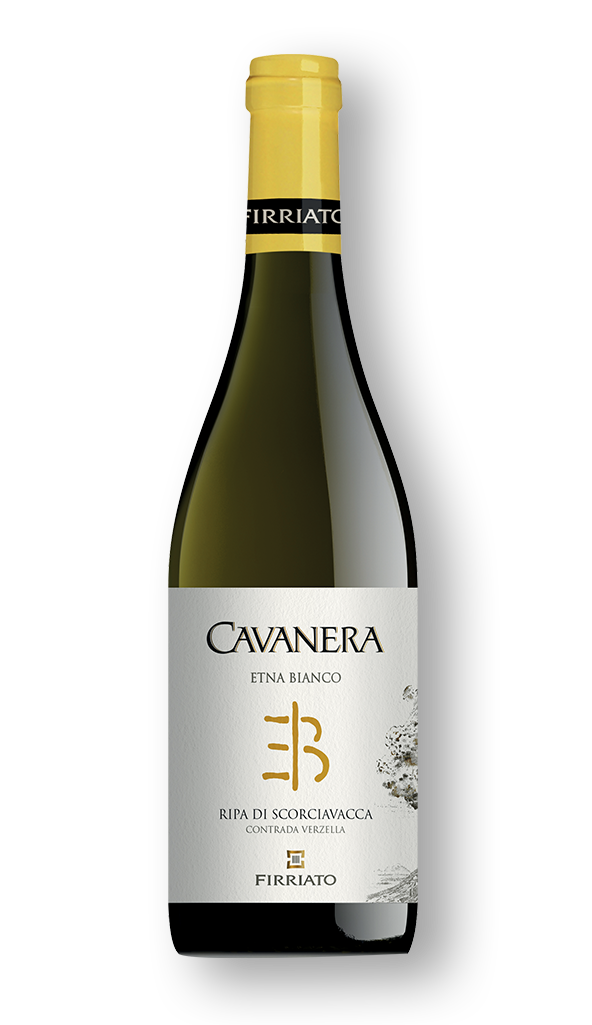
Cru di Carricante and Catarratto from ancient Etna vineyards, bred with specific agronomic practices aimed at enhancing the frankness and unique characteristics that make the profile of the Etna Terroir unmistakable. A long-lived white, which arises from the meticulousness with which each plant is induced, through covering the bunches, to slow down the ripening process of the grapes, with the aim of encouraging a gradual aromatic accumulation. A defined, vertical Etna DOC, balanced in its acidity and softness components, savory and with a long persistence.

Cru di Carricante e Catarratto provenienti da antiche vigne dell’Etna, allevati con specifiche pratiche agronomiche volte a esaltare la franchezza e le caratteristiche uniche che rende inconfondibile il profilo del Terroir Etna. Un bianco longevo, che nasce dalla meticolosità con cui ciascuna pianta viene indotta, attraverso la copertura dei grappoli, a rallentare il processo di maturazione delle uve, con il fine di favorire un graduale accumulo aromatico. Un’Etna DOC definito, verticale, bilanciato nelle sue componenti di acidità e morbidezza, sapido e dalla lunga persistenza.
The eruption of Monte Verzella, which occurred between 30 and 25 thousand years ago, during the activity of the Elliptical crater, caused the collapse of the summit part. The eruption was characterized by moderate explosive activity and intense effusive activity which produced a lava flow, causing several dams and the modification of the path of the Alcantara River. The district is characterized by very deep, sandy soils rich in microelements and organic substance. The soils, on the order of Andisoli with a silicon concentration of more than 60%, are exceptionally porous, and the basaltic rocks of the soil substrate guarantee, with the so-called sponge effect, a constant supply of water to the plants. The temperature variations between day and night and the high presence of humidity are very important.

Verzella's district
650 - 730 mt s.l.m.
North-East
During 2021, after a mild spring, the sirocco showed its strength, causing a reduction in rainfall and bringing the harvest forward by about a week.
Despite a slight drop in production, largely attributable to the altitude and exposure to northern winds, the quality of the grapes was excellent. The wine obtained is characterized by its olfactory refinement and an acid and mineral balance which makes it extremely pleasant on the palate.
On Etna a harvest to remember, the best of the last five years. More than favorable picture; in late May, there was an almost total absence of precipitation together with a significant decrease in rainfall - during the second ten days of June - which led to an earlier harvest, bringing the harvest period back by about a week compared to 2020.
In the twelve different districts, in which Firriato has a wealth of differentiated pedoclimatic conditions, the harvest began in the third ten days of September and continued during the first week of October with the Carricante and Catarratto for the production of the company's Cavanera Ripa di Scorciavacca Cru Etna Bianco DocThis year, in view of the seasonal change and the strong climatic uncertainties, it was decided not to expose the bunches too much to protect them from sunburn and possible storms and hailstorms.
The climatic trend of the first months of 2018 was characterized by a mild winter and a spring with average temperatures. The summer, on the contrary, was characterized by rain and bad weather. Precipitation was more abundant and particularly concentrated in June, the wettest month of the last thirty years, according to regional averages.
Despite the early summer rains, the Etna vineyards benefited from favorable climatic conditions, preserving the grapes in the most delicate stages of fruit development and maturation. The month of September recorded a slight increase in humidity and minimum temperatures compared to last year, but without ever causing particular phytosanitary problems. Overall, vegetative-productive development was regular, with the plants regaining better vigor, restoring production potentials that had lowered the previous year due to significant thermal and water stress. The arrival of heavy and abundant rains starting from the end of September played a positive role especially for the Carricante.
In the summer of 2017, the anomalous heat that hit all of Italy also influenced the mountain viticulture of Cavanera Etnea, bringing forward the traditional ripening periods of the grapes and, consequently, the harvest. This allowed us to preserve the acidity and freshness of the grapes, with results in the bottle that meet modern international trends. The native Carricante, bred north of the volcano, has shown great resistance to the heat wave, standing out for less turgid bunches, characterized by a greater concentration of qualitative components: the profile of its aromatic heritage has remained almost unchanged.
The same goes for Catarratto which, despite being subjected to exceptional climatic conditions, has reconfirmed its great ability to be able to give, together with Carricante, savory whites with a marked minerality and aromatic endowment.
An unforgettable year thanks above all to an almost uniform and very balanced climate with summer temperatures that always remained below the seasonal average, with the absence of heat waves on the eastern side of Sicily. In the Etna area the harvest began at the end of September, a month affected by scattered but not persistent rainfall, and continued until October, characterized, however, by sunny days and a moderately dry climate. The quality of the white grapes was found to be optimal from a phytosanitary point of view thanks to a slow and perfectly balanced maturation of the bunches which suggests fragrant whites, with an excellent balance between softness and freshness, an authentic expression of the Etna Terroir.
The climatic trend was decisive for the quality of the grapes produced, after the spring and early summer rains, the temperatures gradually approached the seasonal averages, but without peaks of heat. Finally we have returned to a more "Etna style" vintage. In the month of September the rains arrived but despite the concern that made us think of a difficult vintage, the month of October, the fateful month of the harvest, was merciful with sunny days and no rain, allowing us to bring grapes from the point of view to the cellar. from an excellent health point of view with leaf surface/production ratios in a state of absolute balance (approximately 1m2 of leaf surface per kg of grapes). Excellent harvest although less productive.
The year was excellent for white grapes. Consequently the wines are very elegant mineral, the red wines with excellent structure thanks to the excellent phenolic maturation.
The vintage appears to be fruitful, both in quantity and above all in quality, "wines with an interesting aromatic profile" were obtained. Due to the climate, the harvest lasted until the last week of September. The 2013 vintage allowed for a slower harvest and therefore gradual maturation.
Collection date: 10 October
The favorable climatic conditions of this vintage allowed excellent and exquisite ripening of the indigenous Carricante and Catarratto grapes. The winter on the north-eastern side of the volcano was cold and with not very abundant rainfall, followed by a spring with normal temperatures, preparing the vines as best as possible for an optimal yield. In summer there was a warm climate which balanced the ripening process of the vines, giving them energy and vitality. The second ten days of October began the harvest.
Its winemaking began with a soft pressing of the grapes which was followed by fermentation at a controlled temperature. We continued with the refinement on the lees with daily stirring for about 4 months, and after bottling the wine was further refined for 3 months after which it was placed on the market.
The climatic conditions were quite stable, allowing for a winter with average temperatures and lower rainfall compared to previous years. The rains were abundant in the spring months, preparing the vineyard in the best possible way, which produced optimally ripe and healthy grapes. However, the harvest, which took place manually between the second and third ten days of October, recorded a 15% drop in production, due to the small size of the bunch. In qualitative terms there is no doubt that it was an excellent year.
The climate of the 2010 vintage was characterized by a winter with normal temperatures and little rainfall and a mild spring with little rain. The drought of the summer season insinuated the possibility of a fruit not conforming to its known perfection, but thanks to the intervention of favorable rainfall at the end of September, the harvest did not disappoint expectations. The harvest period passed with cool temperatures, oscillating between 20 and 22°C, and with abundant rainfall, distinguishing itself by a delay of a few days in the hand-harvesting operations of the grapes, due to their slow maturation.
The budding of the plants was delayed compared to previous years as a result of the favorable climate trend during the year. The autumn season was characterized by a fairly harsh climate and abundant rainfall, which was also frequent in spring. In this first phase, the growth of the vines slowed down considerably, proceeding regularly in the very hot and humid summer months. The vegetative cycle was constant and allowed for excellent ripening of the fruits, which were harvested manually.
During 2021, after a mild spring, the sirocco showed its strength, causing a reduction in rainfall and bringing the harvest forward by about a week.
Despite a slight drop in production, largely attributable to the altitude and exposure to northern winds, the quality of the grapes was excellent. The wine obtained is characterized by its olfactory refinement and an acid and mineral balance which makes it extremely pleasant on the palate.
On Etna a harvest to remember, the best of the last five years. More than favorable picture; in late May, there was an almost total absence of precipitation together with a significant decrease in rainfall - during the second ten days of June - which led to an earlier harvest, bringing the harvest period back by about a week compared to 2020.
In the twelve different districts, in which Firriato has a wealth of differentiated pedoclimatic conditions, the harvest began in the third ten days of September and continued during the first week of October with the Carricante and Catarratto for the production of the company's Cavanera Ripa di Scorciavacca Cru Etna Bianco DocThis year, in view of the seasonal change and the strong climatic uncertainties, it was decided not to expose the bunches too much to protect them from sunburn and possible storms and hailstorms.
The climatic trend of the first months of 2018 was characterized by a mild winter and a spring with average temperatures. The summer, on the contrary, was characterized by rain and bad weather. Precipitation was more abundant and particularly concentrated in June, the wettest month of the last thirty years, according to regional averages.
Despite the early summer rains, the Etna vineyards benefited from favorable climatic conditions, preserving the grapes in the most delicate stages of fruit development and maturation. The month of September recorded a slight increase in humidity and minimum temperatures compared to last year, but without ever causing particular phytosanitary problems. Overall, vegetative-productive development was regular, with the plants regaining better vigor, restoring production potentials that had lowered the previous year due to significant thermal and water stress. The arrival of heavy and abundant rains starting from the end of September played a positive role especially for the Carricante.
In the summer of 2017, the anomalous heat that hit all of Italy also influenced the mountain viticulture of Cavanera Etnea, bringing forward the traditional ripening periods of the grapes and, consequently, the harvest. This allowed us to preserve the acidity and freshness of the grapes, with results in the bottle that meet modern international trends. The native Carricante, bred north of the volcano, has shown great resistance to the heat wave, standing out for less turgid bunches, characterized by a greater concentration of qualitative components: the profile of its aromatic heritage has remained almost unchanged.
The same goes for Catarratto which, despite being subjected to exceptional climatic conditions, has reconfirmed its great ability to be able to give, together with Carricante, savory whites with a marked minerality and aromatic endowment.
An unforgettable year thanks above all to an almost uniform and very balanced climate with summer temperatures that always remained below the seasonal average, with the absence of heat waves on the eastern side of Sicily. In the Etna area the harvest began at the end of September, a month affected by scattered but not persistent rainfall, and continued until October, characterized, however, by sunny days and a moderately dry climate. The quality of the white grapes was found to be optimal from a phytosanitary point of view thanks to a slow and perfectly balanced maturation of the bunches which suggests fragrant whites, with an excellent balance between softness and freshness, an authentic expression of the Etna Terroir.
The climatic trend was decisive for the quality of the grapes produced, after the spring and early summer rains, the temperatures gradually approached the seasonal averages, but without peaks of heat. Finally we have returned to a more "Etna style" vintage. In the month of September the rains arrived but despite the concern that made us think of a difficult vintage, the month of October, the fateful month of the harvest, was merciful with sunny days and no rain, allowing us to bring grapes from the point of view to the cellar. from an excellent health point of view with leaf surface/production ratios in a state of absolute balance (approximately 1m2 of leaf surface per kg of grapes). Excellent harvest although less productive.
The year was excellent for white grapes. Consequently the wines are very elegant mineral, the red wines with excellent structure thanks to the excellent phenolic maturation.
The vintage appears to be fruitful, both in quantity and above all in quality, "wines with an interesting aromatic profile" were obtained. Due to the climate, the harvest lasted until the last week of September. The 2013 vintage allowed for a slower harvest and therefore gradual maturation.
Collection date: 10 October
The favorable climatic conditions of this vintage allowed excellent and exquisite ripening of the indigenous Carricante and Catarratto grapes. The winter on the north-eastern side of the volcano was cold and with not very abundant rainfall, followed by a spring with normal temperatures, preparing the vines as best as possible for an optimal yield. In summer there was a warm climate which balanced the ripening process of the vines, giving them energy and vitality. The second ten days of October began the harvest.
Its winemaking began with a soft pressing of the grapes which was followed by fermentation at a controlled temperature. We continued with the refinement on the lees with daily stirring for about 4 months, and after bottling the wine was further refined for 3 months after which it was placed on the market.
The climatic conditions were quite stable, allowing for a winter with average temperatures and lower rainfall compared to previous years. The rains were abundant in the spring months, preparing the vineyard in the best possible way, which produced optimally ripe and healthy grapes. However, the harvest, which took place manually between the second and third ten days of October, recorded a 15% drop in production, due to the small size of the bunch. In qualitative terms there is no doubt that it was an excellent year.
The climate of the 2010 vintage was characterized by a winter with normal temperatures and little rainfall and a mild spring with little rain. The drought of the summer season insinuated the possibility of a fruit not conforming to its known perfection, but thanks to the intervention of favorable rainfall at the end of September, the harvest did not disappoint expectations. The harvest period passed with cool temperatures, oscillating between 20 and 22°C, and with abundant rainfall, distinguishing itself by a delay of a few days in the hand-harvesting operations of the grapes, due to their slow maturation.
The budding of the plants was delayed compared to previous years as a result of the favorable climate trend during the year. The autumn season was characterized by a fairly harsh climate and abundant rainfall, which was also frequent in spring. In this first phase, the growth of the vines slowed down considerably, proceeding regularly in the very hot and humid summer months. The vegetative cycle was constant and allowed for excellent ripening of the fruits, which were harvested manually.
The harvest of Etna whites takes place around the first ten days of October. After a manual harvest with relative selection of the best bunches, the grapes in excellent phytosanitary conditions are taken to the cellar for soft pressing and fermentation at controlled temperatures. Designed to be long-lived, aging times range from 6 months in stainless steel tanks with periodic stirring, to 6 months in glass.

Intense straw yellow color with green reflections.

The enchanting intensity of its aromas is offered in clear olfactory evolutions with hints of yellow country flowers, broom and acacia, combined with fruity notes of white pulp, apple and ripe peach. No less important are the nuances of aromatic herbs. Sweet and infinite, it shines with elegance and body. Aristocratic, pure, it stands out among the great whites of the high seas.

The charm of its mineral essence is unparalleled. Splendid for its stylistic rigor which stands out for its power and roundness. The enveloping sphericity of the imposing structure is an absolute distinctive sign, so much so that it makes it an archetypal volcano wine.

Corona

3 bicchieri

3 bicchieri

92 pt


Ogni bottiglia di Signum Aetnae è conservata all’interno di un sofisticato cofanetto in legno serigrafato, uno scrigno che conferisce un tocco di lusso e raffinatezza al pezzo da collezione. Il cofanetto in legno è realizzato con maestria artigianale e rappresenta un elemento distintivo del packaging. La sua superficie è decorata con un motivo serigrafato di alta qualità che richiama l’identità del vino Signum Aetnae e dell’azienda Firriato.
All’interno del cofanetto, la bottiglia di Signum Aetnae è avvolta con cura in una delicata carta velina, che porta il logo del marchio e un sigillo di autenticità. Questo strato di carta protegge la bottiglia durante il trasporto e contribuisce a creare un’esperienza di apertura memorabile.
All’interno della confezione è presente un pieghevole informativo. Il pieghevole contiene dettagliate istruzioni sull’NFT (Non-Fungible Token) associato al vino Signum Aetnae. Spiega come accedere e godere di contenuti digitali esclusivi tramite l’uso dell’NFT, offrendo un’esperienza unica e coinvolgente per gli appassionati del vino.
All’interno del cofanetto, la bottiglia di Signum Aetnae è avvolta con cura in una delicata carta velina, che porta il logo del marchio e un sigillo di autenticità. Questo strato di carta protegge la bottiglia durante il trasporto e contribuisce a creare un’esperienza di apertura memorabile.
All’interno della confezione è presente un pieghevole informativo. Il pieghevole contiene dettagliate istruzioni sull’NFT (Non-Fungible Token) associato al vino Signum Aetnae. Spiega come accedere e godere di contenuti digitali esclusivi tramite l’uso dell’NFT, offrendo un’esperienza unica e coinvolgente per gli appassionati del vino.
All’interno del cofanetto, la bottiglia di Signum Aetnae è avvolta con cura in una delicata carta velina, che porta il logo del marchio e un sigillo di autenticità. Questo strato di carta protegge la bottiglia durante il trasporto e contribuisce a creare un’esperienza di apertura memorabile.
All’interno della confezione è presente un pieghevole informativo. Il pieghevole contiene dettagliate istruzioni sull’NFT (Non-Fungible Token) associato al vino Signum Aetnae. Spiega come accedere e godere di contenuti digitali esclusivi tramite l’uso dell’NFT, offrendo un’esperienza unica e coinvolgente per gli appassionati del vino.
Ogni bottiglia di Signum Aetnae è accompagnata da un sofisticato cofanetto in legno serigrafato, che aggiunge un tocco di lusso e raffinatezza.
Il cofanetto in legno è realizzato con maestria artigianale e rappresenta un elemento distintivo del packaging. La sua superficie è decorata con un motivo serigrafato di alta qualità che richiama l’identità del vino Signum Aetnae e dell’azienda Firriato.